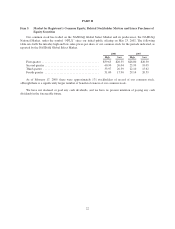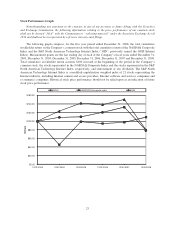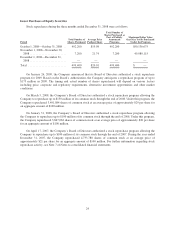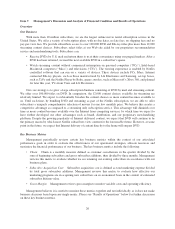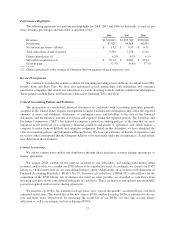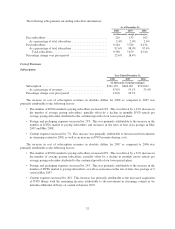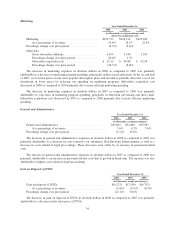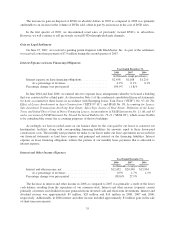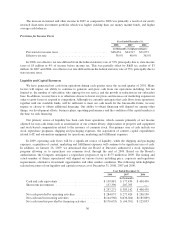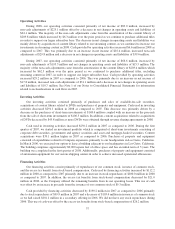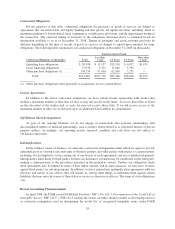NetFlix 2008 Annual Report Download - page 33
Download and view the complete annual report
Please find page 33 of the 2008 NetFlix annual report below. You can navigate through the pages in the report by either clicking on the pages listed below, or by using the keyword search tool below to find specific information within the annual report.For those direct purchase DVDs that we estimate we will sell at the end of their useful lives, a salvage value
of $3.00 per DVD has been provided. For those DVDs that we do not expect to sell, no salvage value is provided.
We periodically evaluate the useful lives and salvage values of our DVDs.
We also obtain content distribution rights in order to stream movies and TV episodes without commercial
interruption to subscribers. We account for streaming content in accordance with SFAS No. 63, Reporting by
Broadcasters (“SFAS 63”), which requires classification of streaming content as either a current or non-current
asset in the consolidated balance sheets based on the estimated time of usage after certain criteria have been met,
including availability of the streaming content for its first showing. We amortize our streaming content on a
straight-line basis generally over the term of the related license agreements or the title’s window of availability.
Cash outflows associated with the streaming content are classified as cash flows from operating activities on our
consolidated statements of cash flows.
We also obtain DVD and streaming content through revenue sharing agreements with studios and
distributors. We generally obtain titles for low initial cost in exchange for a commitment to share a percentage of
our subscription revenues or a fee, based on utilization, over a fixed period, or the Title Term, which typically
ranges from six to twelve months for each title. The initial cost may be in the form of an upfront non-refundable
payment. This payment is capitalized in the content library in accordance with our DVD and streaming content
policies as applicable. The initial cost may also be in the form of a prepayment of future revenue sharing
obligations which is classified as prepaid revenue sharing expense. The terms of some revenue sharing
agreements with studios obligate us to make minimum revenue sharing payments for certain titles. We amortize
minimum revenue sharing prepayments (or accrete an amount payable to studios if the payment is due in arrears)
as revenue sharing obligations are incurred. A provision for estimated shortfall, if any, on minimum revenue
sharing payments is made in the period in which the shortfall becomes probable and can be reasonably estimated.
Under the revenue sharing agreements for our DVD library, at the end of the Title Term, we generally have the
option of returning the DVD to the studio, destroying the DVD or purchasing the DVD.
Additionally, the terms of certain DVD direct purchase agreements with studios provide for volume
purchase discounts or rebates based on achieving specified performance levels. Volume purchase discounts are
recorded as a reduction of DVD library when earned. We accrue for rebates as earned based on historical title
performance and estimates of demand for the titles over the remainder of the title term.
Stock-Based Compensation
We adopted the provisions of SFAS No. 123(R), Share-Based Payment (“SFAS 123R”), on January 1, 2006.
Under the fair value recognition provisions of this statement, stock-based compensation cost is estimated at the
grant date based on the fair value of the awards expected to vest and is recognized as expense ratably over the
requisite service period, which is the vesting period.
We changed our method of calculating the fair value of new stock-based compensation awards under our
stock plans from a Black-Scholes model to a lattice-binomial model on January 1, 2007. We continue to use a
Black-Scholes option model to determine the fair value of employee stock purchase plan shares. The lattice-
binomial model has been applied prospectively to options granted subsequent to January 1, 2007. The lattice-
binomial model requires the input of highly subjective assumptions, including the option’s price volatility of the
underlying stock. Changes in the subjective input assumptions can materially affect the estimate of fair value of
options granted and our results of operations could be materially impacted.
•Expected Volatility: Our computation of expected volatility is based on a blend of historical volatility
of our common stock and implied volatility of tradable forward call options to purchase shares of our
common stock. Our decision to incorporate implied volatility was based on our assessment that implied
volatility of publicly traded options in our common stock is more reflective of market conditions and,
therefore, can reasonably be expected to be a better indicator of expected volatility than historical
volatility of our common stock.
28






